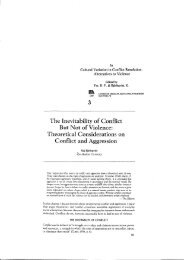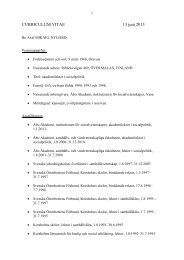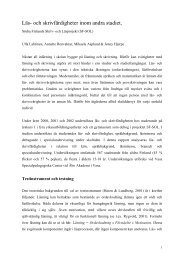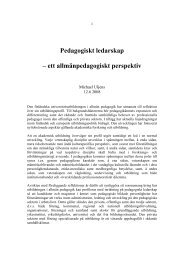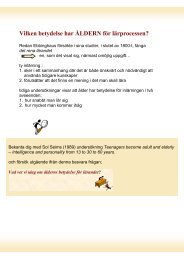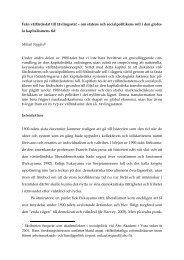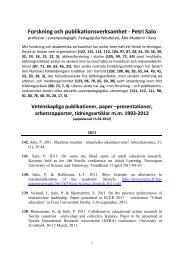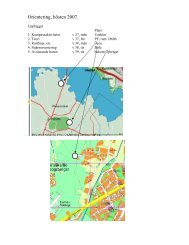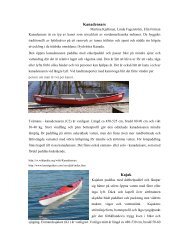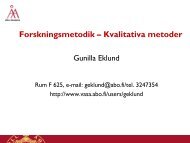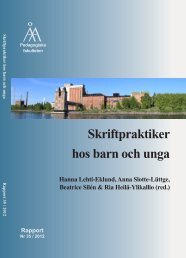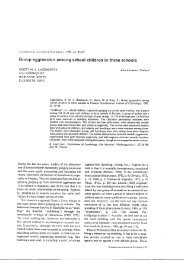Parties, Candidates and Citizens On-Line - Åbo Akademi
Parties, Candidates and Citizens On-Line - Åbo Akademi
Parties, Candidates and Citizens On-Line - Åbo Akademi
You also want an ePaper? Increase the reach of your titles
YUMPU automatically turns print PDFs into web optimized ePapers that Google loves.
The Finnish context<br />
As was briefly mentioned in the introduction, Finl<strong>and</strong> has several important<br />
characteristics to keep in mind when studying c<strong>and</strong>idate level electoral competition on the<br />
internet. These characteristics are discussed in detail in the following section.<br />
The basic prerequisite for web campaigning during elections – a high level of<br />
internet penetration – has long been fulfilled in Finl<strong>and</strong> (cf. Norris 2000). In 1999,<br />
roughly one third of the 5.2 million population was on-line, a share which by mid 2002<br />
had risen to 52 per cent 1. Where parties <strong>and</strong> c<strong>and</strong>idates in many countries are still so-tospeak<br />
‘learning the ropes’ of internet campaigning, the Finnish political actors should be<br />
relatively familiar with the medium. In fact, as stated by Gibson <strong>and</strong> Römmele (2005: 10),<br />
Finl<strong>and</strong>, alongside the USA <strong>and</strong> Germany, is a world-leader in terms of internet use by<br />
political c<strong>and</strong>idates. Concerning voter impact, research findings suggest that there seems<br />
to be a growing potential for catching the next generation of Finnish voters (e.g.<br />
Bengtsson & Grönlund 2005; Borg & Moring 2005; Moring 2003). The share of young<br />
voters (18-34 years) – a voter segment all Finnish parties regard as a part of their target<br />
groups (Moring 2003: 18) – ranking internet sources as most important in making their<br />
voting decision has already risen from 10 per cent in the 1999 parliamentary election to<br />
over 30 per cent in the 2003 election. In 2003, internet sources were even ranked above<br />
traditional sources for election information, such as TV <strong>and</strong> newspapers by the same<br />
young voters (ibid.: 18-9). The internet is starting to move beyond the status of a ‘second<br />
order campaign medium’ when considering its impact on the elections in Finl<strong>and</strong>.<br />
The 200 seats of the parliament are contested once every four years in the Finnish<br />
parliamentary elections. The MPs are elected from 15 districts where the district<br />
magnitude is based on the population size in each district. Consequently, more seats in<br />
parliament are allocated to the larger districts. The districts are quite different in nature,<br />
ranging from the highly urbanized <strong>and</strong> crowded Helsinki area to the rural <strong>and</strong> sparsely<br />
populated northern <strong>and</strong> eastern parts of the country. The MP seats are distributed<br />
between the parties using the d’Hondt system 2 of party list proportional representation<br />
(Sundberg 1997; Taagapera & Shugart 1989: 31-2). Furthermore, compared to other<br />
European countries, <strong>and</strong> of special interest in studying c<strong>and</strong>idate campaigning, the<br />
Finnish elections are c<strong>and</strong>idate-centred, as votes are cast for the c<strong>and</strong>idates <strong>and</strong> not the<br />
party (Carlson 2006; Ruostetsaari & Mattila 2002). The elections are not only a<br />
competition between parties but a competition between individual c<strong>and</strong>idates (Sundberg<br />
1997: 72). Many c<strong>and</strong>idates also have their own support groups which organize campaign<br />
activities, raise funds <strong>and</strong> try to increase publicity for the c<strong>and</strong>idate (Ruostetsaari &<br />
Mattila 2002). According to Gibson (2004), such c<strong>and</strong>idate-centred systems spur<br />
individual innovation <strong>and</strong> dynamic use of political websites. <strong>C<strong>and</strong>idates</strong> <strong>and</strong> parties are<br />
121



